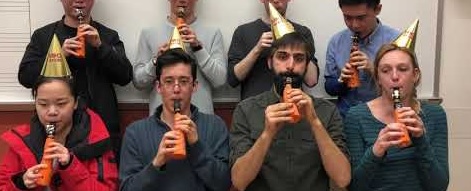
Category: AMN mentors

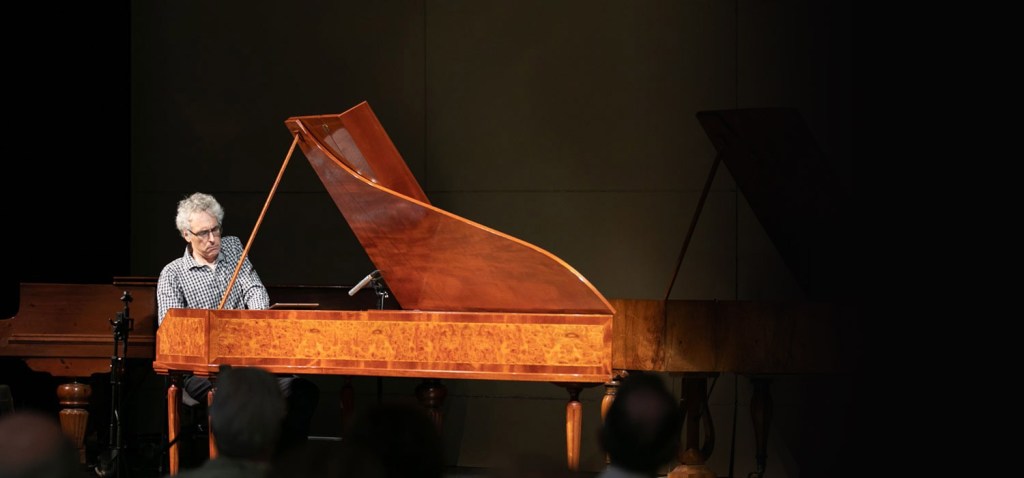
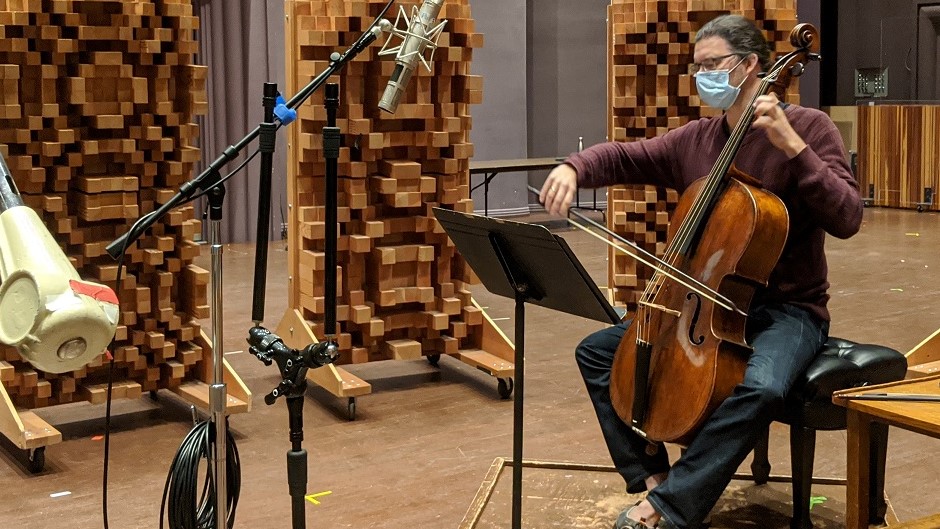

We’re launching our Early Music for Modern Instruments month with a very special four-workshop series taught by Baroque violinist Elizabeth Blumenstock. The series begins Tuesday, October 6, at 7 p.m. PDT, and continues on Tuesday evenings through October 27.
Elizabeth is a longtime concertmaster, soloist, and leader with the Bay Area’s Philarmonia Baroque Orchestra and American Bach Soloists; concertmaster of the International Handel Festival in Goettingen, Germany; and artistic director of the Baroque Music Festival Corona del Mar. In a normal year, she’d be traveling almost nonstop to concerts and teaching engagements around the world. Because of the COVID-19 pandemic, she’s been sheltering in place in her rural New Mexico housing cooperative, where she’s reading, practicing, and “trying to create garden beds out of the rocky wilderness.” We spoke with her about her life in music and her plans for the AMN workshops.
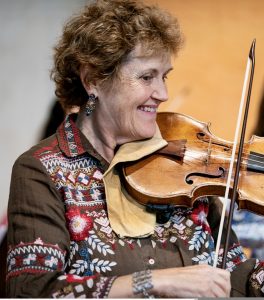
How did you get started with the violin?
I’d started playing the piano when I was 6. When I was 7, and living in Princeton, New Jersey, my mother fell in love with a local violin player, and suddenly I was taking violin lessons. It didn’t work out between my mother and the violin teacher, but it worked out fine between me and the violin! I liked practicing, and I was reasonably good at playing in tune and in time.
I kept up with piano too, and also the organ, and for 21 years I played the organ in a small church in Richmond, California.
What sparked your interest in Baroque violin?
My mother had been a church organist, and so I grew up with Bach and other Baroque music. Then, when I was 21—this would have been in 1972—I was playing in a string quartet and the first violinist brought us the first recordings of all of the Bach cantatas on period instruments. I was instantly smitten by the colors, the timbre, the way the instruments blended together and how the music was shaped dynamically. I went away knowing this was what I wanted to do.
But actually doing it took a little longer! Hardly anyone in the U.S. was doing it at that time.
When did you start doing it?
In the years after falling in love with historical performance, I played viola in the Rotterdam Philharmonic. Gigged around the Bay Area, got married, and had two children. Then in 1980 I heard about a newly formed group, Philharmonia Baroque Orchestra of the Golden West, as Philharmonia Baroque was called then. I called them up and said, “I really want to play in your orchestra, but I don’t have a Baroque violin.” “We have one you can use,” I was told. “I don’t have a Baroque bow, either.” “Not a problem—we have one you use.” And that was pretty much it!
Nowadays there are 30 applicants for every open violin position and there’s a formal procedure with auditions behind a screen. I was very lucky to get in on the ground floor.
You now play a very special instrument. Can you tell us about it?
I play a violin made in 1660 by Andrea Guarneri, the founder of the famous Guarneri violin-making family. It’s on generous permanent loan from the Philharmonia Baroque Orchestra, a gift from an extremely generous anonymous donor.
When the gift was arranged, I was told I could start looking for a fine violin. Over the course of the next several months, and trips to Boston, Chicago, New York, Los Angeles, San Francisco, Portland, and Albuquerque, I selected a total of seven instruments to try again and played them for a group of violin colleagues.
There was one violin, from Boston—every time I picked it up I went ooohhh. It was so clear and colorful. That instrument was our nearly unanimous choice.Imagine—this violin was 25 years old when Bach was born! And that’s the one I now play.
It’s not mine to keep, though. When I stop playing with Philharmonia I must give it back to the orchestra.
In the second session of your AMN series, on October 13, you’ll discuss “rhetorical music.” That term may be new to many participants—what does it mean?
Baroque music has borrowed a lot from rhetoric—the art of public speaking. Composers embedded the techniques of effective public speaking into their music, and it was also embedded in the approach to performance. Phrase structure is like sentence structure, with commas and periods and leaning on important “words.” When you play in the rhetorical style, I suspect you turn on the part of the listener’s brain that processes speech and meaning. You tell a story through music.
What are some tips for modern violinists who want to play early music?
Expression in the Baroque style lies in the right hand—the bow arm—and not so much in the left. If you choke up on your modern bow, like you’d choke up on a baseball bat, it shifts the balance and makes it behave a bit more like a Baroque bow.
What would you do if you weren’t a musician?
Part of me always wished I could dance. But in a way, playing the Baroque violin is so gestural that I feel as though I am in fact dancing with my arms and hands and fingers!
*
Watch a 2014 video of Elizabeth Blumenstock playing her 1660 Guarneri.
Read more about our Early Music for Modern Instruments series.

From jazz to salsa to samba, the San Francisco Bay Area is a vibrant hub of Afro-Latin music—and one of the reasons is percussionist John Santos, who for 45 years has played an essential role in bringing the full range of Afro-Latin music to a wide audience. On October 3, John—a generous teacher, performer, and recording artist—will join us in an online conversation about some fundamental Latin percussion instruments: tumbadora (conga drum), guiro, claves, cowbell, and chekeré. You don’t need to own any of those instruments–or any percussion instruments at all–to enjoy and benefit from the workshop. Just tapping out the rhythms with John will be valuable for all musicians, percussionists or not. Moderator Dee Spencer will keep the conversation flowing and take your questions.
We chatted recently with John to learn more about his musical background.
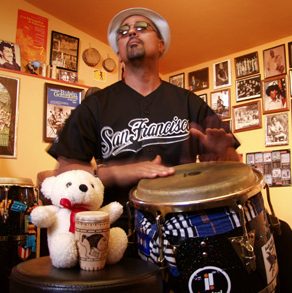
What were your early musical influences?
I was born in San Francisco in 1955 into a musical family. My grandparents on both sides were professional musicians—from Puerto Rico on my mother’s side and from Cape Verde on my father’s side. My parents had a large record collection—jazz, Cuban, Puerto Rican—and I also listened to whatever my older brothers and cousins listened to, from Jimi Hendrix and the Beatles to Motown and B.B. King.
In the third grade I began playing a clarinet that I inherited from my brothers. But by sixth grade I was more interested in percussion. I never looked back.
When did you start performing?
My dad had gone to school in San Francisco with some great musicians—Carlos Duran, Manny Duran, Eddie Duran, Benny Velarde, Carlos Federico. The Duran brothers and Benny Velarde went on to play with Cal Tjader’s Latin jazz band. When I was about 14 and playing congas, my dad took me to the clubs where they were playing. I even got to sit in with them. I was underage, but as long as I drank only Shirley Temples no one minded!
Tell us about your musical education.
I learned from Armando Peraza and Francisco Aguabella, two master musicians. [Peraza, who died in 2014, played congas and bongos with the rock band Santana.] I didn’t take formal lessons, but I learned an incredible amount just listening to their stories and watching them play. And in the mid-1980s, after 15 years of my bugging him, I finally persuaded Francisco to give me formal lessons.
I’ve also learned through teaching. Since 1986 I’ve taught at Jazz Camp West—which is now in La Honda, near Santa Cruz—for a week every year. It’s a magical week—nothing but music in the redwoods. Concerts every night. My kids, who are 12 and 15, grew up there. This year, because of the pandemic, we had virtual camp.
Can you recommend a good resource for Latin percussion instruments?
The Haight Ashbury Music Center, which opened in the 1970s, shut down earlier this year, but Gelb Music in Redwood City, is run by the same people and carries the same great inventory. I managed the percussion department at the Haight Ashbury Music Center throughout the 1980s, so I know it’s good!
Some of the participants in your AMN workshop may be new to Afro-Latin percussion. What do they need to know beforehand?
All they need is an open mind. The traditions that this music represents are part of an African legacy that is being reclaimed and retold. It was marginalized for many years, but it survived and evolved.
*
Learn more about John Santos on his website. The John Santos Sextet’s new album, Art of the Descarga, was released in August by Smithsonian Folkways Recordings.